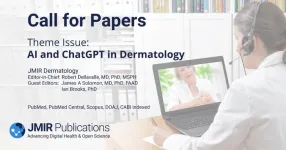(Press-News.org)
Researchers at University of Manchester and the École polytechnique fédérale de Lausanne (EPFL), Switzerland, have revealed an innovative approach to track individual molecule dynamics within nanofluidic structures, illuminating their response to molecules in ways never before possible.
Nanofluidics, the study of fluids confined within ultra-small spaces, offers insights into the behaviour of liquids on a nanometer scale. However, exploring the movement of individual molecules in such confined environments has been challenging due to the limitations of conventional microscopy techniques. This obstacle prevented real-time sensing and imaging, leaving significant gaps in our knowledge of molecular properties in confinement.
A team led by Professor Radha Boya in the Department of Physics at The University of Manchester makes nanochannels which are only one-atom to few-atom thin using two-dimensional materials as building blocks.
Prof Boya said: “Seeing is believing, but it is not easy to see confinement effects at this scale. We make these extremely thin slit-like channels, and the current study shows an elegant way to visualise them by super-resolution microscopy.”
The study's findings are published in the journal Nature Materials.
The partnership with the EPFL team allowed for optical probing of these systems, uncovering hints of liquid ordering induced by confinement.
Thanks to an unexpected property of boron nitride, a graphene-like 2D material which possesses a remarkable ability to emit light when in contact with liquids, researchers at EPFL's Laboratory of Nanoscale Biology (LBEN) have succeeded in directly observing and tracing the paths of individual molecules within nanofluidic structures.
This revelation opens the door to a deeper understanding of the behaviours of ions and molecules in conditions that mimic biological systems.
Professor Aleksandra Radenovic, head of LBEN, explains: "Advancements in fabrication and material science have empowered us to control fluidic and ionic transport on the nanoscale. Yet, our understanding of nanofluidic systems remained limited, as conventional light microscopy couldn't penetrate structures below the diffraction limit. Our research now shines a light on nanofluidics, offering insights into a realm that was largely uncharted until now."
This newfound understanding of molecular properties has exciting applications, including the potential to directly image emerging nanofluidic systems, where liquids exhibit unconventional behaviours under pressure or voltage stimuli.
The research's core lies in the fluorescence originating from single-photon emitters at the hexagonal boron nitride's surface.
Doctoral student Nathan Ronceray, from LBEN, said: “This fluorescence activation came unexpected as neither hexagonal boron nitride (hBN) nor the liquid exhibit visible-range fluorescence on their own. It most likely arises from molecules interacting with surface defects on the hBN crystal, but we are still not certain of the exact mechanism,”
Dr Yi You, a post-doc from The University of Manchester engineered the nanochannels such that the confining liquids mere nanometers from the hBN surface which has some defects.
Surface defects can be missing atoms in the crystalline structure, whose properties differ from the original material, granting them the ability to emit light when they interact with certain molecules.
The researchers further observed that when a defect turns off, one of its neighbours lights up, because the molecule bound to the first site hopped to the second. Step by step, this enables reconstructing entire molecular trajectories.
Using a combination of microscopy techniques, the team monitored colour changes to successfully demonstrate that these light emitters emit photons one at a time, offering pinpoint information about their immediate surroundings within around one nanometer. This breakthrough enables the use of these emitters as nanoscale probes, shedding light on the arrangement of molecules within confined nanometre spaces.
The potential for this discovery is far-reaching. Nathan Ronceray envisions applications beyond passive sensing.
He said: “We have primarily been watching the behaviour of molecules with hBN without actively interacting with, but we think it could be used to visualize nanoscale flows caused by pressure or electric fields.
“This could lead to more dynamic applications in the future for optical imaging and sensing, providing unprecedented insights into the intricate behaviours of molecules within these confined spaces.”
The project received funding from the European Research Council, Royal Society University Research Fellowship, Royal Society International Exchanges Award and EPSRC New Horizons grant.
END
Peering into nanofluidic mysteries one photon at a time
2023-08-31
ELSE PRESS RELEASES FROM THIS DATE:
Study demonstrates adding complex component of milk to infant formula confers long-term cognitive benefits
2023-08-31
LAWRENCE, KANSAS — Breast milk is widely acknowledged as the most beneficial nutrition for infants, but many families face medical or logistical challenges in breastfeeding. In the U.S., just 45% of infants continue to be exclusively breastfed at 3 months of age, according to the Centers for Disease Control.
For decades, researchers have sought to create a viable complement or alternative to breast milk to give children their best start for healthy development. New research out of the University of Kansas has shown how a complex component of milk that can be added to infant ...
Do artificial roosts help bats? Illinois experts say more research needed
2023-08-31
URBANA, Ill. — Artificial roosts for bats come in many forms — bat boxes, condos, bark mimics, clay roosts, and cinder block structures, to name a few — but a new conservation practice and policy article from researchers at the University of Illinois Urbana-Champaign suggests the structures haven’t been studied rigorously enough and may harm bats in some scenarios. The article, published in Conservation Biology, lays out potential dangers and encourages more research on the popular conservation practice.
“The major emphasis among conservation managers using artificial roosts is how to attract ...
JMIR Dermatology call for papers theme issue on AI and ChatGPT in dermatology
2023-08-31
JMIR Dermatology Editor-in-Chief: Robert Dellavalle, MD, PhD, MSPH and guest editors James A Solomon, MD, PhD, FAAD and Ian Brooks, PhD welcome submissions to a special theme issue examining "Artificial Intelligence (AI) and ChatGPT in Dermatology."
JMIR Dermatology welcomes all topics related to diseases of the skin, hair, and nails, with a wide breadth and depth of papers focusing on AI applications. All topics at the intersection of dermatology, AI, and ChatGPT are eligible for this theme issue.
The journal ...
An ‘introspective’ AI finds diversity improves performance
2023-08-31
An artificial intelligence with the ability to look inward and fine tune its own neural network performs better when it chooses diversity over lack of diversity, a new study finds. The resulting diverse neural networks were particularly effective at solving complex tasks.
“We created a test system with a non-human intelligence, an artificial intelligence (AI), to see if the AI would choose diversity over the lack of diversity and if its choice would improve the performance of the AI,” says William Ditto, professor of physics at North Carolina State University, director ...
Penn State professor to lead field campaign to study climate in Baltimore area
2023-08-31
UNIVERSITY PARK, Pa. — Kenneth Davis, professor of atmospheric and climate science at Penn State, will lead a team of 23 investigators from 13 research institutions in a new field campaign supported by the U.S. Department of Energy (DOE) to study surface-atmosphere interactions around Baltimore, Maryland, to see how they influence the city’s climate. The new campaign, called the Coast-Urban-Rural Atmospheric Gradient Experiment (CoURAGE), is expected to start in October 2024 and run through September 2025.
CoURAGE will contribute to the Baltimore Social-Environmental ...
Covid pandemic may have changed the gut bacteria of infants, research finds
2023-08-31
Infants who spent most of their first year in the pandemic have fewer types of bacteria in their gut than infants born earlier, according to a team of developmental psychology researchers.
The findings, published in Scientific Reports, showed that infants whose gut microbes were sampled during the pandemic had lower alpha diversity of the gut microbiome, meaning that there were fewer species of bacteria in the gut. The infants had a lower abundance of Pasteurellaceae and Haemophilus—bacteria that live within humans and can cause various infections—and significantly different beta diversity, which tells us how similar or dissimilar the gut microbiome for ...
New blood test gives very high accuracy to screen for Alzheimer’s disease
2023-08-31
A new blood test called p-tau217 shows promise as an Alzheimer's disease biomarker, and when used in a two-step workflow very high accuracy to either identify or exclude brain amyloidosis, the most important and earliest pathology. That is an innovation now presented by researchers at the University of Gothenburg, together with colleagues at University of Lund and in Montreal, Canada.
In recent years, a lot of effort has been put on developing biomarkers in blood that could potentially help to identify Alzheimer’s disease (AD). Tau protein, ...
Antioxidants stimulate blood flow in tumors
2023-08-31
Vitamin C and other antioxidants stimulate the formation of new blood vessels in lung cancer tumours, a new study from Karolinska Institutet published in The Journal of Clinical Investigation shows. The discovery corroborates the idea that dietary supplements containing antioxidants can accelerate tumour growth and metastasis.
“We’ve found that antioxidants activate a mechanism that causes cancer tumours to form new blood vessels, which is surprising, since it was previously thought that antioxidants have a protective effect,” says study leader Martin Bergö, professor at the ...
Talk therapy with other moms an effective treatment for postpartum depression, McMaster research shows
2023-08-31
HAMILTON, ON (Aug. 31, 2023) – An innovative model of care that offers new mothers psychotherapy delivered by other mothers who have also experienced post-partum depression (PPD) should be implemented in clinical practice, according to researchers at McMaster University.
Researchers worked with nearly 200 mothers over a year and a half, during the height of the COVID-19 pandemic, and found those receiving treatment from their peers were 11 times more likely to experience remission of their major depressive disorder. The findings of the randomized control trial are published in Acta Psychiatrica Scandinavica.
PPD and its associated symptoms affect ...
Single-dose psilocybin treatment for major depressive disorder
2023-08-31
About The Study: In a randomized clinical trial with 104 participants, psilocybin treatment was associated with a clinically significant sustained reduction in depressive symptoms and functional disability, without serious adverse events. These findings add to increasing evidence that psilocybin—when administered with psychological support—may hold promise as a novel intervention for major depressive disorder.
Authors: Charles L. Raison, M.D., of Usona Institute in Fitchburg, Wisconsin, is the corresponding author.
To access the embargoed study: Visit our For The Media website at ...



